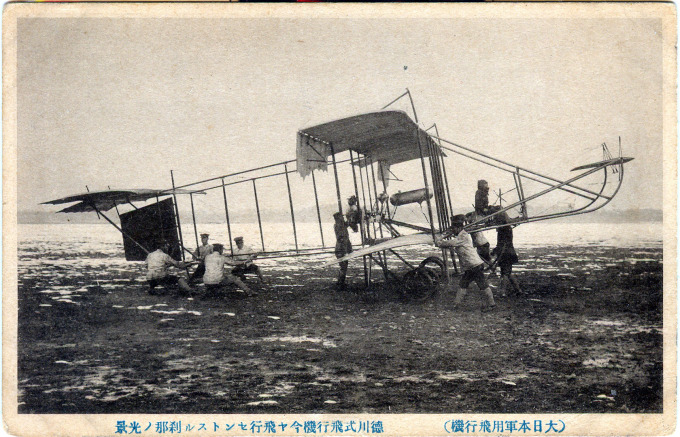“In May 1910, Yoshitoshi Tokugawa, a twenty-seven-year old first lieutenant in the Japanese engineer corps, was of a group of likely candidates selected by various governments to study aviation in France. Together with students from Germany, Poland, and Austria, he entered the Farman school at Etampes.”
“Instruction then consisted of ten five-minute training flights at an altitude of thirty meters [100 feet]. The pupil was wedged in behind the instructor’s back and had to reach over his shoulder to hold the stick. [Because of engine torque,] left-hand turns were easier in flight than right; and these were the only kind allowed.
“The process was somewhat comparable to learning how to ride a bicycle. After just a few solo flights the students were ‘graduated’.”
– Contact!: The Story of the Early Aviators. by Henry Serrano Villard, 2002

Vintage B&W photo postcard of the first airplane flight in Japan, December 19, 1910, by Imperial Japanese Army officer Yoshitoshi Tokugawa, piloting a Farman III biplane from the open field at Yoyogi Parade Ground, Tokyo.
“In 1909, Tokugawa was sent as a military attaché to France, specifically to study aeronautical engineering and military applications for the use of aircraft in combat. He purchased a Farman III biplane, which he shipped back to Japan.
“On 19 December 1910, Tokugawa flew Japan’s first successful powered aircraft flight at Yoyogi Parade Ground where Tokyo’s Yoyogi Park is now located, only seven years after the Wright Brothers’ flight in the United States. On 5 April 1911, Tokugawa also piloted the inaugural flight from Japan’s first permanent airfield, Tokorozawa.”
– Wikipedia


Pingback: “Kamikaze”, Tokyo-London World Record Flight, 1937. | Old Tokyo
Pingback: Nieuport IV at Tokorozawa Airfield, c. 1912. | Old Tokyo
Pingback: Juichi Sakamoto, Pioneer Aviator, c. 1914. | Old Tokyo
Pingback: Narahara #4 “Otori-go” Aeroplane, c. 1912. | Old Tokyo
Pingback: Izaki No. 2 “Sempu-go”, Kyoto Aero Club, c. 1915. | Old Tokyo
Pingback: “Life in the Army” series, IJAAS parade field fly-over, c. 1914. | Old Tokyo
Pingback: The first trip to Japan was 7 years after the brothers of Wright – outdoorbang.com